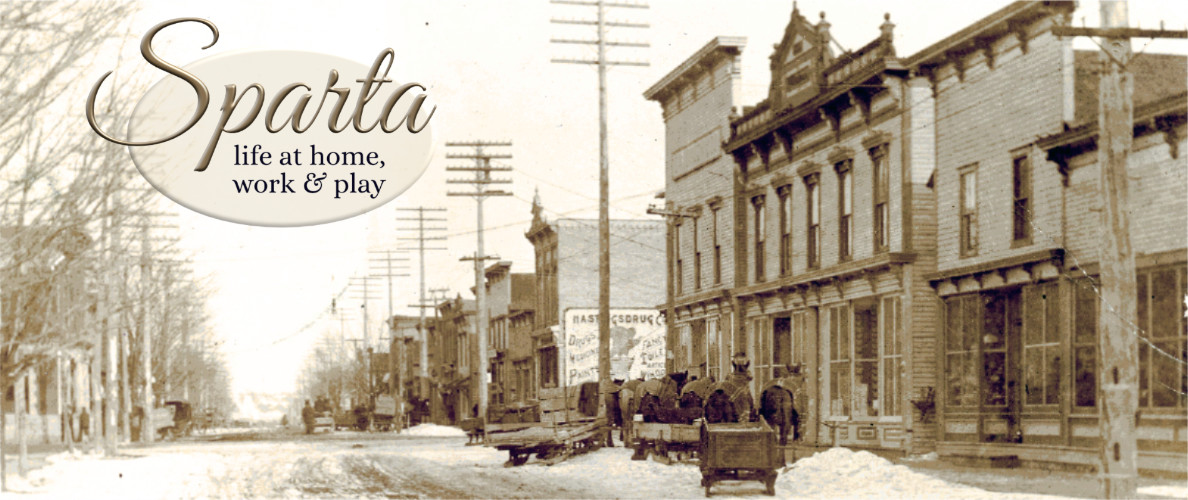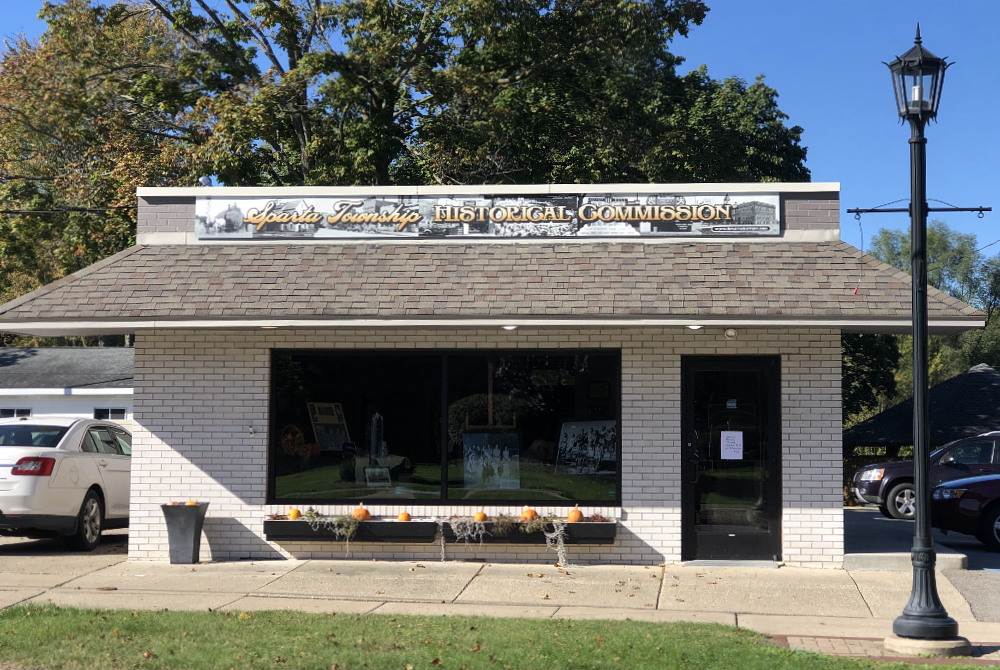

Village Articles
Milo & Ben Stories of two friends and early Sparta businessmen: "Milo Bolender's Pharmacy" and "Dr. Benjamin Zudzense & His Monkeys"
"Charles Henry Loomis" From drugs to hardware
Hometown Hero "Mad Dogs & Marshall Meeker"
The Highway Arrived State Street corridor and post-war growth: "Camp Boys Come to Town" and "Sparta Builders" address the housing shortage
Merry & Bright How we celebrated: "Sparta's Easter Bunny Helper", "A Very Sparta Christmas", "My Christmas Memories", and "Christmases Past"
Mad Dogs &
Marshal Meeker
Albert H. Meeker
The son of Allen & Electa (Hilton) Meeker, Albert was born on June 6th, 1852, at Sparta and grew up near Lisbon. In 1877, he married Ida May Boorom and worked on the family farm. Ida's parents were Anthony & Sally M. (Finch) Boorom. Albert lost his wife in 1886 and married again in 1890 to Nora, the daughter of John & Julia E. (Chambers) Brown. The Meekers were blessed with four daughters.
When the 1900 Federal Census was enumerated, the Albert Meeker family resided in Sparta. His occupation was that of a “produce dealer” while he earned a living as the owner of an apple-drying business situated between Maple and what would later become Washington Streets, south of Centennial. But that’s a story in itself for another time.
- I Remember Sparta's First Mad Dog Scare by Arzie Pinckney
published in the Sentinel Leader Dec 2, 1964
Late one afternoon a young lady by the name of Myrtle Miller was on her way home after a day's work in the Tyroller Clothing and Millinery Store, now the Paris Bakery. She lived with her parents, Mr. and Mrs. Frank Miller on the first farm east of the river bridge on the south side of the road... As she was crossing the first bridge, she met a large shepherd dog. She stopped, talked to it and petted it, and went on her way.
The dog came on and the first dog it met was one that belonged to Roy Wallace. (He lived where Tom Feerick now lives.) Roy's dog was always running out and snapping and barking at everyone that passed their house and we kids were scared of it. When the shepherd dog came along, Roy's dog rushed out barking at him as usual. He chased him up on the porch and bit him, then went on his way up the street and bit several other dogs but did not seem to pay any attention to people.
The news that a mad dog was loose in town spread like wild fire. Everyone that had a gun, pitchfork, or any other kind of weapon joined the hunt. Most of them were out all night. Just after daylight, our town marshal, Mr. Albert Meeker, caught sight of him. He was a crack shot with a rifle and one shot was enough. The dog's head was sent to Ann Arbor to be examined and sure enough the report came back that he did have rabies. You may be sure that everyone was thankful that Al got the dog before the children started school.
Mr. and Mrs. Meeker were the parents of Mrs. George Brace, Mrs. Bert Young, Mrs. Inez Stebbins, and Mrs. Theodore Baker, Sr. Al was a real nimrod. For years he made his trek to the north woods and the deer country and seldom came home empty handed. He made his last trip in his 89th year. When he got home, he cleaned and oiled the old rifle and hung up his hunting outfit.
As soon as the news came from Ann Arbor, there was a round-up of dogs. At that time, there was no law in the village governing dogs, so most of them ran loose. Unless you had a special pet, they had the run of the village. So every dog that was known to be a philander and a loose liver was under suspicion that he might have been bitten or been with the mad dog. He was gone over with a fine tooth comb and if they found a fresh mark or scratch on him and if its owners didn't have an iron clad alibi, it was curtains for him.
Even the St. Bernard of Dr. Griner’s didn’t escape the executioner. He was a huge animal. I believe that he was the biggest dog that ever came to Sparta. He looks as though he could carry a good-sized keg of brandy or whatever it was that dogs were supposed to carry in snowstorms. He was the most gentle brute and all the kids loved him as soon as they got over being afraid of him. But he couldn’t explain where he was on the night in question, so he bit the dust.
There was a shortage of dogs in the village for quite awhile. We seldom heard of a dog barking at the moon or every time there was a train whistle or the church bells rang. It took quite awhile to get the dog population back to normal. Meanwhile, the cats had a long holiday and they got fat and lazy because there were so few dogs to exercise them for most of the dogs were home on a chain.
It was March of 1903 when Arzie’s mad dog story took place. Various newspaper accounts reveal more than one mad dog was recently on the loose in Sparta—within the month.
The Isabella County Enterprise article with the headline of Mad Dog Ran Wild. read: “Sparta, Mich., March 18.—A mad dog ran wild in the streets here Monday night, biting all that came within reach until yesterday morning, when it was shot by the marshal. There has been great excitement here in consequence. Both the township and village boards of health have held meetings and ordered all dogs muzzled, and all that have been bitten are to be shot. Seven dogs were killed yesterday and more are to follow.”
Excited Over a Mad Dog. headed the report in the Osceola County Democrat. “Sparta, Mich., March 20.—A mad dog ran loose all Monday night, biting all other dogs that came in its path. The dog was killed Tuesday, but the town is excited and a wholesale slaughter of dogs is going on. This was the second case of the kind within three weeks. Children are being kept off the streets, and many citizens will not venture out of doors unless they have heavy clubs or revolvers.”
The prospect of a mad dog roaming the area caused fear in the citizenry as a bite from an affected animal would cause rabies, also known as “hydrophobia”. It was commonly called that because the afflicted were known to avoid even the sight of water. An incident at Owosso in Shiawassee county, Michigan, in 1901 stated that an eight-year old boy had been bitten several weeks prior with the wound being cauterized which was thought to prevent the disease. He began showing symptoms which were getting worse. “Part of the time it has required the efforts of four men to hold him in bed.”
The fear was real.
The Sentinel-Leader reported on January 11, 1907, about an “epidemic of hydrophobia” which took place at a small outpost named Smith’s Crossing in Saginaw county as a “mad dog came down the river road from the direction of Midland biting everything in its path. It was finally dispatched by a farmer, whom it attacked, after a fierce battle. So vicious was the dog that the farmer’s horses would not pass it in the road, trembling in their tracks. He beat it off and later with a neighbor killed the animal.” Not only were people and other dogs at risk, but any animal bitten--wild or domestic. “Within the last few days every dog in the hamlet has gone mad, four foaming-mouthed canines being killed in one day. Three hogs belonging to one man went mad from hydrophobia and five cows owned by another villager have become rabid. The cows went rearing and plunging about the barnyard, bellowing with all their might and biting each other. It is believed that many other cattle and hogs, and possibly horses, have been bitten.”
A Ludington widow, Mrs. William Moran, and her ten children were believed to have contracted rabies in 1909 “by drinking milk from a cow recently bitten by a mad dog. They have been rushed to the Pasteur Institute at Ann Arbor.” Reported the Osceola County Democrat. The French scientist, Louis Pasteur, had facilities in the region at the University of Michigan in Ann Arbor, and Chicago, Illinois, where people were treated for rabies with his life-saving serum. As time was of the essence, communities often raised the necessary funds and provided transportation for the unfortunate victims.
The Lansing State Journal included a news brief in their August 3, 1916, issue to alert the public: “The state live stock sanitary commission has placed a quarantine on all dogs in Sparta township for 60 days. Hydrophobia is reported in the township. One dog has been chasing farmers.”
Indeed we are fortunate to be living in an age where mad dogs no longer freely roam and rabies outbreaks are rare.
Contact

Sparta Township Historical Commission headquarters at 71 North Union Street
Our History Center is conveniently located at 71 North Union Street in downtown Sparta. Please join us for coffee and lively conversation on Monday mornings. Visits to the History Center can also be scheduled by appointment, for your convenience.
We do not receive mail at the History Center, instead, please use our mailing address, which is:
attn: Sparta Township Historical Commission
Sparta Township
160 E. Division St.
Sparta MI 49345
Our complete archives are now available online for your convenience. Just click STHC PastPerfect Catalog Access and begin your research!
For other inquiries, the Sparta Township Historical Commission can be reached by phone at: (616)606-0765 or via email at the following address:
